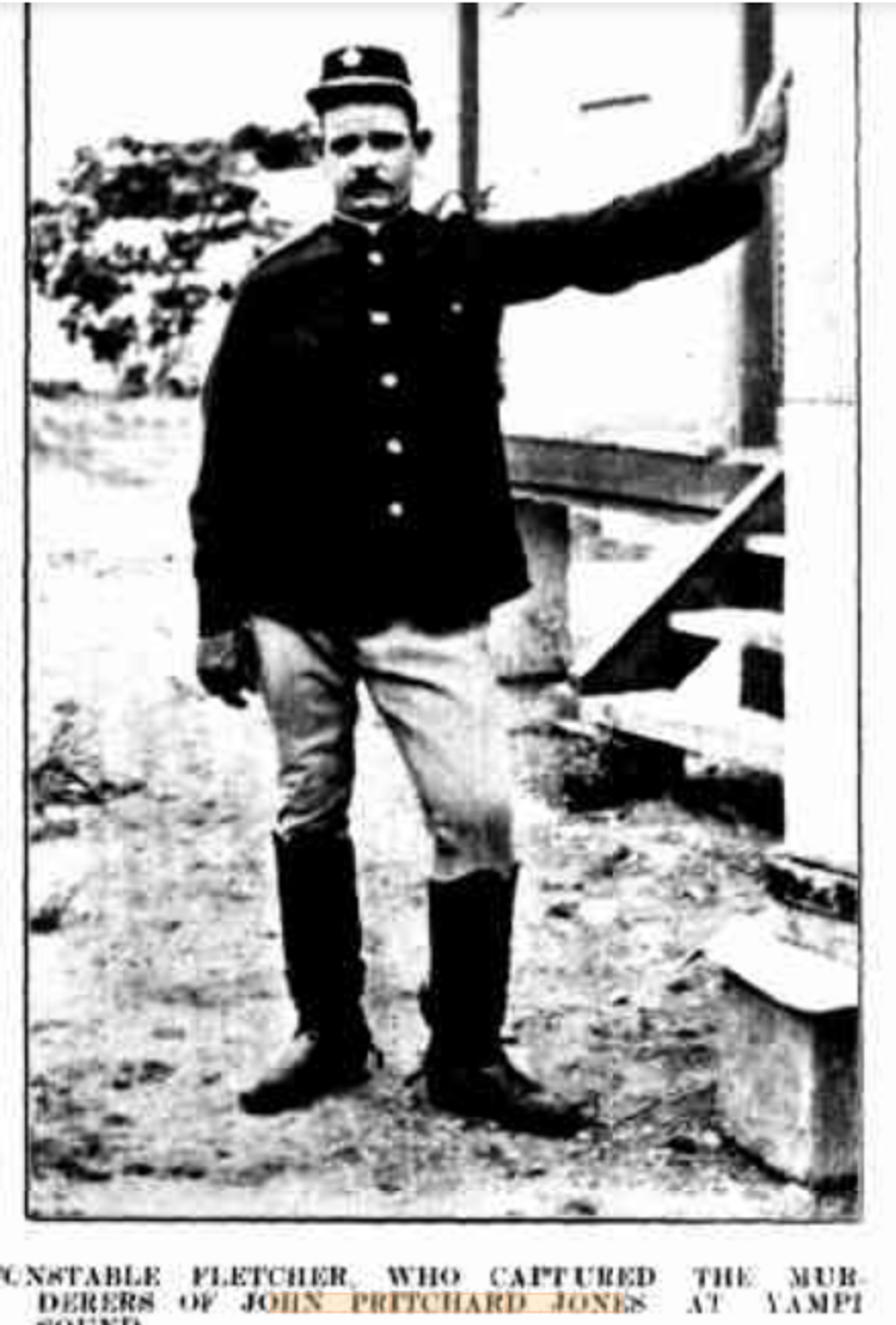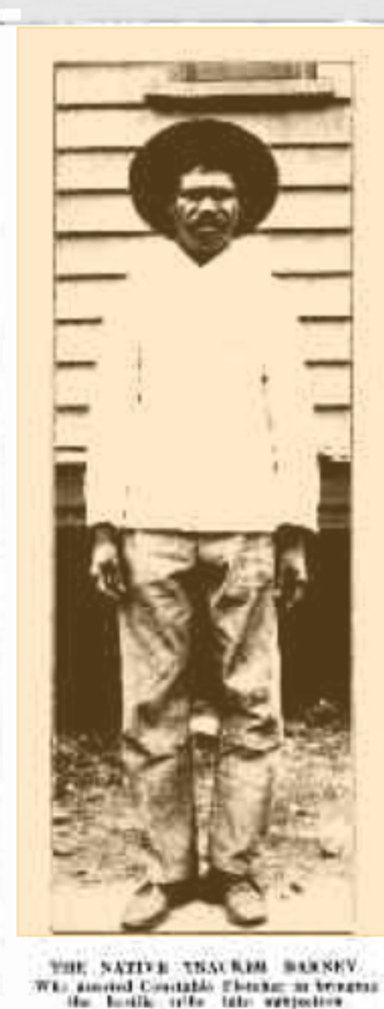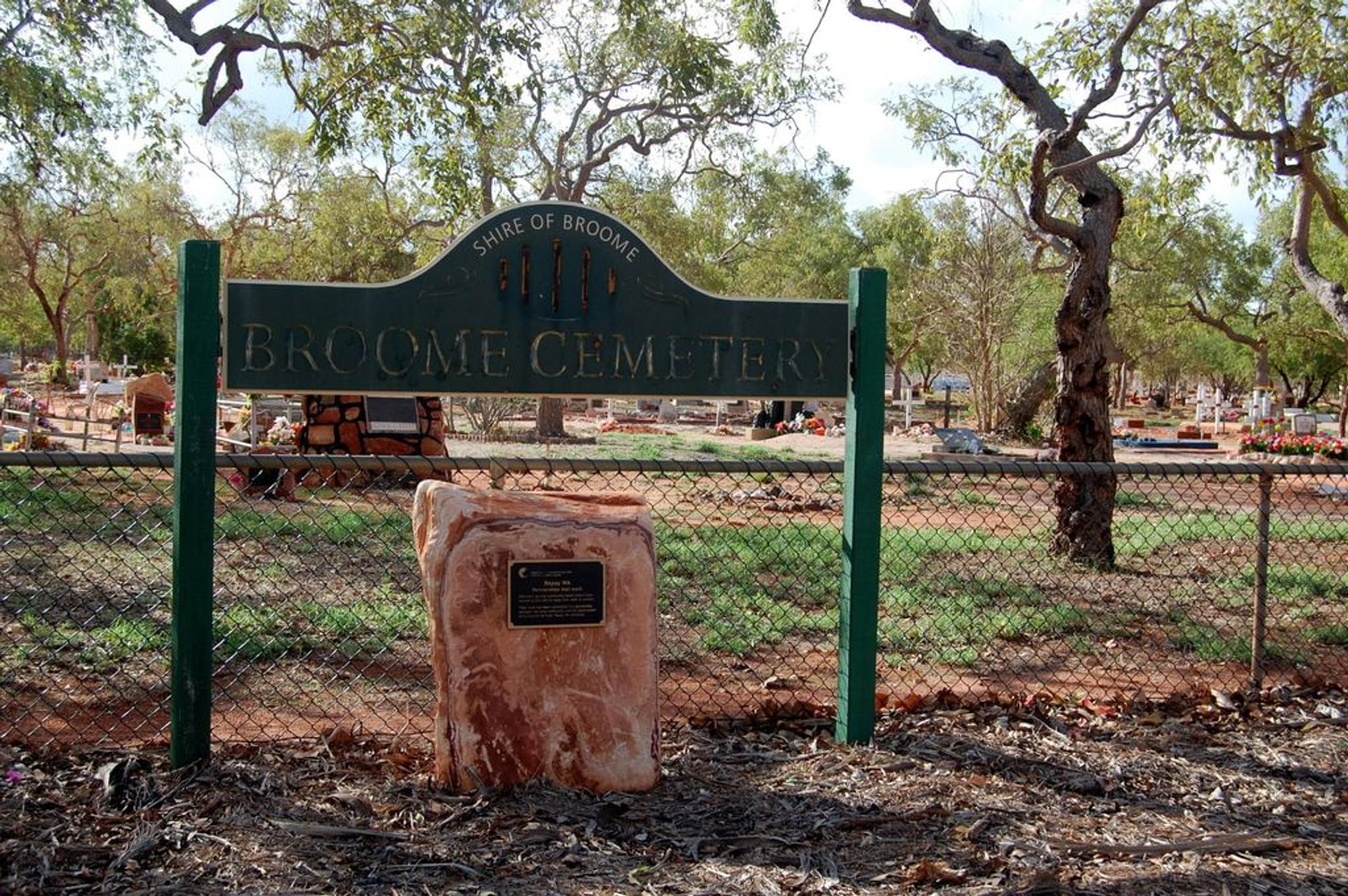John Pritchard Jones
Vessel Name: Lily
John Pritchard Jones
Killed at Yampi Sound; body recovered
24 January 1909

Constable Fletcher

Tracker

Broome Cemetery
John Pritchard Jones was born in 1861 at Carnarvon, Wales. He ventured to Western Australia, and in 1894 married Ann Jane Davies. The couple lived in Derby, and they had two daughters, Myfannwy and Gwedolen. Before he went beachcombing for pearl shell, he was a prison warder.
Frederick C H Massen (“Fred”) was a sailor born in 1874 in Derby. He and John were partners in a beachcombing and gold hunting venture.
John and Fred took Lily from Derby to Yampi Sound and on 18 January 1909 they anchored in the entrance passage, moving along the passage until a sand bar prevented further progress. John was waiting for the spring tide so he could float off the bar and back into open water. In the meantime, he planned to collect shell when the tide was low (beachcombing).
On 19 January local Aboriginal men of the Worrorra group Lowadda and Peter visited the lugger with two other men that John and Fred had not met before. Lowadda and Peter spoke English and for the next few days they traded shell for tobacco and food and stayed on board Lily.
On 24 January John decided to take the boat’s dinghy and move further along the passage to collect shell. Lowadda said he would accompany him in his catamaran, and one of John’s newer acquaintances Nirgang pulled the dinghy. Around 9.30am they started off, and that was the last time Fred saw John alive.
Peter stayed on board Lily with Fred. As the other men disappeared from view, Fred went below to cook some fish. Peter struck him with a tomahawk. Fred was facing away from Peter, and the blow struck his shoulder. Peter struck again, and Fred grabbed the tomahawk, and the men struggled from the cabin onto the deck. Fred pushed Peter overboard, and when he tried to climb back on board, Fred went to fetch his rifle from below decks. His first shot missed. He fired again and the shot entered Peter’s leg. When Peter attempted to board Lily again Fred shot his head. Peter sank below the surface of the water.
At this point John had been gone for three quarters of an hour. Fred fired into the air to signal to John. He did not return. Fred waited for two hours and then pulled up the anchor and headed towards Yampi Sound. He sailed around the area for two days, searching for a signal from John. There was no sign of him, and after the third day Fred set sail for Derby.
On 31 January Fred reported to police in Derby that John was last seen on 24 January and had disappeared. He reported Peter’s attack on him and his shooting. Police Corporal Brodie formed a search party of police constables and two boatmen. They took a lugger to the area described by Fred.
PC Brodie searched an old camp site used by Aboriginal people of the area called Oobagooma. He found what was left of John’s clothes in the deserted camp. Thirty yards away, half a mile from where John had landed ashore, PC Brodie found John’s dinghy. He concluded John was murdered and searched from Graveyard to Collier Bay in search of him. He found no trace and returned to Derby. On 22 February he sent a telegraph to Police Captain Hare and advised Sub-Inspector McCarthy. The Commissioner was informed.
On 19 November 1909 Police Corporal Bertram Henry Fletcher left Derby with his tracker Barney aboard the lugger Rita. He intended to investigate John’s murder and track the men who had killed him. Finally in December 1909 PC Fletcher made contact with the Worrorra people who lived in the area near Oobagooma.
On 24 November while anchored at the Graveyard, PC Fletcher saw a group of Aboriginal men with Lily’s dinghy. He arrested four of the men: Mingilna, Mingilngoo, Thurmingar (Harry) and Mongoon (Jim Crow) who were imprisoned for four months for taking John’s dinghy.
PC Fletcher found it difficult to determine who was involved in John’s murder and who witnessed it, and who was not related to the case. After several attempts he took the whole clan to Derby. There he asked questions, took statements and worked out who was guilty. He kept the guilty and important witnesses and released the rest.
After talking to the men, he charged two of them with murder, and on 26 December he returned to Yampi Sound in the Cupid (owned by Mr Hunter) to return the two of the men arrested earlier and arrest five others.
On board, Lowadda resisted a return to Derby, and in a struggle that ensued, both he and PC Fletcher fell overboard. PC Fletcher refused to let go of Lowadda and they were washed downstream. Eventually landing on an island half a mile away. Once Lowadda was safely returned to the Cupid, all five Aboriginal men were taken to Derby prison.
The trial was not until 4 April 1910. The men were kept in prison, and it was custom to detain the witnesses as well. Sadly, Mingilna died awaiting the trial. He had tuberculosis (consumption), which may have been exacerbated by prison conditions. Thurminger was considered a witness and was not formally charged with the six others who were remanded for trial charged with “wilful [premeditated] murder”.
Resident Magistrate G T Wood presided over the trial, which was held in Broome. It seems the six Aboriginal men charged with murder, and the witnesses gave similar details of the incident. Kallygnuroo struck John’s head with a stick and John fell to the ground. Other men hit John with sticks. Then others hit him with sticks and spears. They buried John’s body and put stones on his grave. Then men then moved to Meda country to avoid detection.
The medical examiner from Broome Doctor John Henry Saunders reported that the bones found at the old camp were European and had a damaged skull and a broken pelvis. The bones found by the police party showed a 40- to 50-year-old man who was 5 ft 4 in tall with good teeth. The measurements, clothes and dinghy together with witness evidence led to the conclusion the body was without question that of John Pritchard Jones.
The trial of the six men concluded on 5 April 1910, when the jury returned a verdict of guilty of “wilful murder”. They were sentenced to death – Kallygnuroo, Nirging, Lowadda, Mingilngoo, Yourngoo and Dowerunga,
On 21 May 1910, the six condemned men had their sentences commuted by the Executive Council. Their sentences were reduced to “penal servitude for life”.
John Jones' remains were buried in Broome Cemetery after the inquiry into his death. Fred Massen remained at sea for some years. He died at the age of 68, having relocated to Denmark, West Australia. He is buried in the Karrakatta Cemetery in the Lutheran Section.
